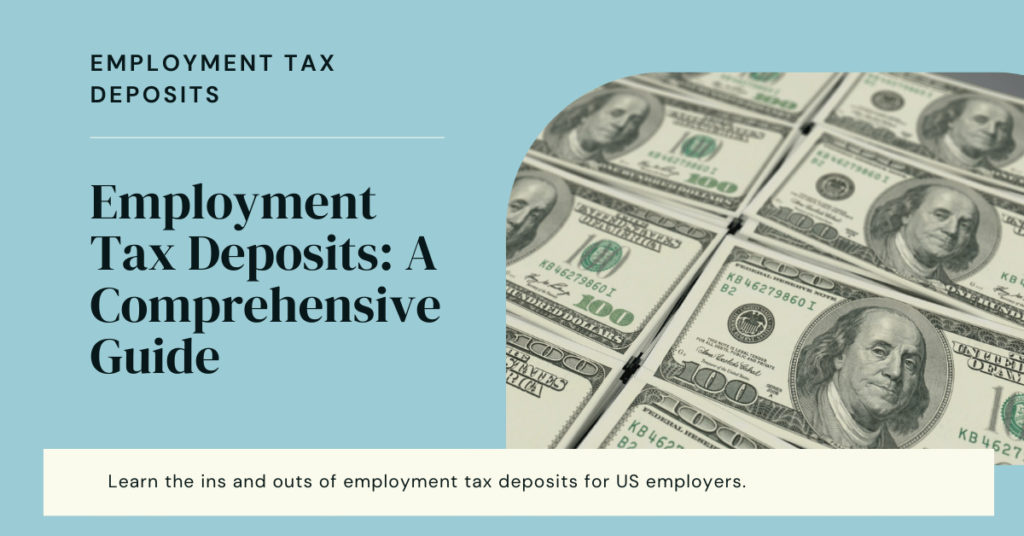As a responsible employer in the United States, understanding the intricacies of employment tax deposits is paramount to ensure compliance with IRS regulations. The process involves depositing employment taxes reported on Forms 941 or 944, covering federal income tax, social security, and Medicare tax. This comprehensive guide aims to demystify the deposit schedules, liabilities, and essential procedures associated with employment tax deposits, providing clarity for employers navigating this crucial aspect of financial management.

Deciphering Employment Tax Liabilities: Under $2,500 and $2,500 or More
Liability under $2,500:
For employers with an employment tax liability of less than $2,500, flexibility exists. Filing Form 941 or Form 944 allows these employers to pay taxes with their timely filed return instead of making separate deposits, provided the $100,000 next-day deposit obligation is not incurred during the current quarter.
Liability of $2,500 or more:
Employers with an employment tax liability of $2,500 or more face stricter deposit requirements. Unless eligible to make payments with the return, they must deposit their taxes. Adhering to the deposit schedules is crucial to avoid failure-to-deposit penalties.
Understanding Employment Tax Deposit Schedules: Monthly and Semiweekly
Monthly Schedule Depositor:
Employers reporting taxes of $50,000 or less during the lookback period are categorized as monthly schedule depositors. Deposits for wages paid during a month must be made on or before the 15th day of the following month.
Semiweekly Schedule Depositor:
Employers reporting taxes of more than $50,000 during the lookback period fall into the semiweekly schedule depositor category. Deposit schedules are as follows:
- If payday is Wednesday, Thursday, or Friday, deposits are due by the following Wednesday.
- If payday is Saturday, Sunday, Monday, or Tuesday, deposits are due by the following Friday.
The due date may shift to the next business day if it falls on a weekend or legal holiday. Employers have at least 3 business days after the close of the semiweekly period to make a deposit.
$100,000 Next-Day Deposit Rule:
Employers accumulating $100,000 or more in taxes on any day during a deposit period must deposit the taxes by the next business day. This triggers a shift to semiweekly deposits for the remainder of the calendar year and the following year.
Special Considerations for New Employers:
New employers are considered monthly schedule depositors in their first year of business unless the $100,000 Next-Day Deposit Rule applies.
Read Instructions about Form 941 and Form 944
comparison between Form 941 and Form 944 presented in a table format:
| Feature | Form 941 | Form 944 |
|---|---|---|
| Filing Frequency | Quarterly | Annually (for eligible small businesses) |
| Reporting Period | Quarter-wise | Annual |
| Liability Calculation | Calculated for each quarter | Calculated for the entire year |
| Due Date | Last day of the month following the quarter | Generally January 31 of the following year (February 10 if timely deposits made) |
| Eligibility | Applicable to businesses of all sizes | Designed for small businesses with estimated annual tax liability of $1,000 or less |
| Administrative Ease | Requires quarterly filing | Simplifies the process with one annual filing for eligible businesses |
| IRS Notification Requirement | Not applicable | Employers must indicate eligibility on Form SS-4 or be notified by the IRS |
This table provides a quick overview of the key differences between Form 941 and Form 944, making it easier to decide which form aligns better with your business needs.
How to Deposit: Electronic Funds Transfer (EFT)
All federal tax deposits must be made using electronic funds transfer (EFT). The Electronic Federal Tax Payment System (EFTPS) is the preferred method, allowing timely scheduling up to 8 p.m. Eastern time the day before the due date.
If EFTPS is not preferred, employers can enlist the services of tax professionals, financial institutions, payroll services, or trusted third parties to make electronic deposits. Same-day payment options are available, but employers must arrange this with their financial institution in advance.
Ensuring Compliance and Avoiding Penalties:
Employers are required to deposit 100% of their tax liability by the due date. Penalties may apply for late deposits, insufficient amounts, or mailing payments directly to the IRS. The accuracy of deposit rules and penalty waivers are detailed in Publication 15.
Conclusion: Navigating Employment Tax Deposits with Confidence
In the complex landscape of employment tax deposits, knowledge and adherence to IRS regulations are the cornerstones of responsible financial management. This comprehensive guide equips employers with the understanding of deposit schedules, liabilities, and procedures, empowering them to navigate the intricacies of employment tax deposits with confidence.
